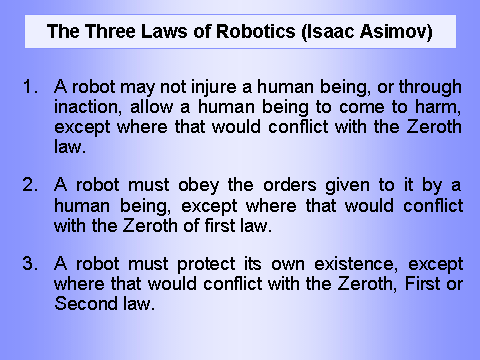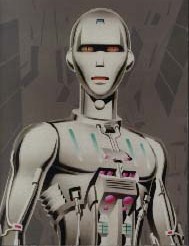The Three Laws of Robotics |
Isaac Asimov developed his Three Laws of Robotics to counter the traditional view of robots in science fiction that robots were created and they immediately turned on and destroyed their creators. Asimov got the idea from Adam Link’s thought “A robot must never kill a human, of his own free will,” from Otto Binder story “Adam Link’s Vengeance” (1940). He quickly wrote and published the story “Robbie” (1940), whose main character was “a sympathetic and noble robot”. Though Isaac Asimov is given full credit for creating the Three Laws, he attributes their development to editor John W. Campbell, who in turn credits Asimov for thinking of them. However they came into being, the Three Laws guided Asimov’s writing for several years.
Attempting to make the human character understand how the laws work, the robots often explain that the Three Laws as they actually exist in a robot’s mind are not the written, verbal version usually quoted by humans, but abstract mathematical concepts upon which a robot’s entire developing consciousness is based, comparable to basic human instincts of family or mating, and thus are closer to forming the basis or a robot’s self-consciousness—a sense that its entire purpose is based around serving humanity, obeying human orders and continuing its existence in this mode—rather than arbitrary limitations circumscribing an otherwise independent mind.
Though Isaac Asimov retained the rights to his Three Laws, he allowed other authors to use them as long as he was given credit. Some authors, such as Mark Tiedemann and Gregory Benford, both wrote about the laws and continued some of Asimov’s plots. They did not alter the laws in any way, as others did. For example, Roger MacBride Allen asked Asimov’s permission to write a trilogy within Asimov’s universe that was based on laws similar to Asimov’s. Allen’s New Laws have some major differences: the First Law does not have the ‘inaction’ clause; the Second Law requires cooperation instead of obedience; the Second Law does not supersede the Third Law; and a Fourth Law allows robots to do anything as long as it does not conflict with the first Laws (“Three Laws” Wikipedia). According to Wikipedia, the laws were changed so the robots would be partners with humans and not slaves. |
 |

